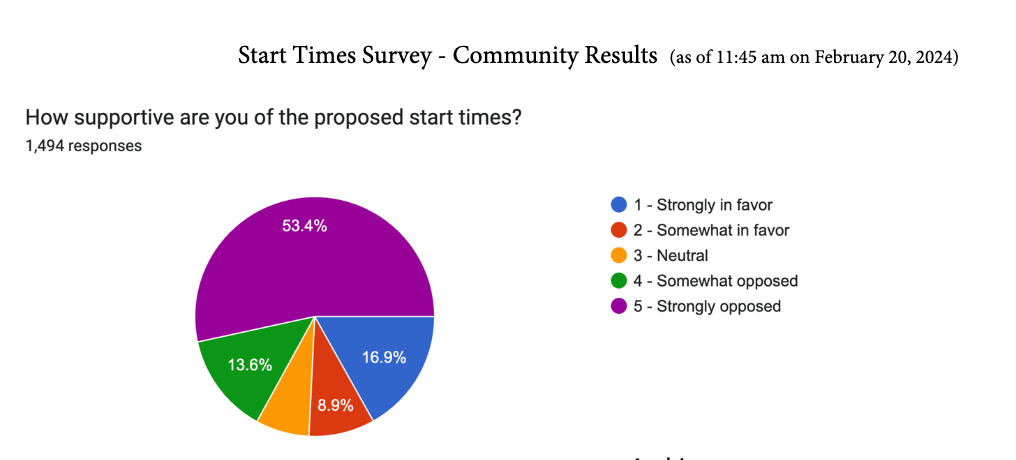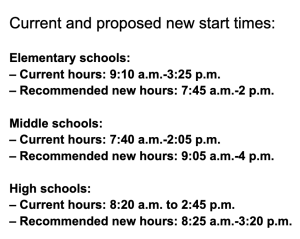
By Haley Thomas, contributor
As the Harrisonburg City School Board considers new school day times, the early returns from a survey of the district’s staff and community members show that a lot of people aren’t fans of the proposal. Board members said the pushback wasn’t a surprise, but when presented in color, the strength of that opposition was striking.
“We knew some of this, but not in this vibrant of a display,” said board chair Andy Kohen.
Superintendent Michael Richards presented the data collected thus far to the board at its work session Tuesday. He said the survey targets those who would be impacted by implementing new start times and has gathered data from parents, teachers, students and other stakeholders. Richards said the survey, which had nearly 1,500 responses from community members and more than 600 from district staff, is still open and that this data is merely a “snapshot” from responses collected through Tuesday morning.
“It’s a lot of purple,” Board member Deb Fitzgerald said, referencing the “strongly opposed” portion of each graph and met by nodding heads from other board members.
“The community is not particularly pleased by this,” Fitzgerald added.
The proposed changes, recommended by a School Start Times Task Force for the 2024-25 school year, would have the city’s elementary schools starting 90 minutes earlier and middle schools starting 90 minutes later, while shifting the high school schedule up by five minutes.

Fitzgerald said when she considers the new start and end times, she thinks of it in two separate pieces. The first being “the ability for kids to get sleep and do well in school,” of which the importance is backed up by research, she added.
The second piece, she said, was “can we make coherent schedules that don’t mess up everybody’s lives in order to follow that research?”
Board member Kristen Loflin focused on the number of survey responses that cite childcare plans as a major issue with the new start and end times. Richards said the school division has funding in its budget to help cover the cost of children attending childcare centers after school, which he called “very unusual for a school district.”
“Our school liaisons work with families who need childcare, and we’re trying to get the word out [about available funding] as much as we can,” Richards said. “But it would be really great if there was a concerted effort to upgrade childcare…We’re very much aware of that need, and we’re trying to support that need.”
Board member Emma Phillips said she would like to see the city make an effort to meet these needs.
“It makes me really concerned when our school system bears too much of the weight [of childcare] because it means we may not be doing other things as well, like educating our students,” Phillips added. “I recognize that we need to support our students, but I would like to see some of that weight be carried by other parts of our community.”
Transportation was another factor behind the district’s exploration of new start and ending times. Board member Kaylene Seigle said the district is understaffed with bus drivers because it has fewer drivers than the 60 buses available. That means the district has double loads for some bus routes, she said.
The district employs 46 full-time bus drivers, according to numbers city spokesman Michael Parks provided later.
Additionally, an hour and twenty minutes is the required time gap needed between elementary and high school bus routes to safely get all students to their respective schools. Board members concurred that changing bus drivers’ already complicated schedules could create more issues on their end.
Phillips said the proposed start and end times aren’t a perfect solution. In fact, she said, adjusting school start and end times to fix one problem created more issues in other areas.
The board members agreed to leave the survey open until March 1, and they will take an official vote at their next business meeting on March 5.
High school to try out new security tech
Harrisonburg City Public Schools will pilot Opengate, a program that aims to enhance security in schools, later this semester. Opengate is a screening system for people wearing backpacks, purses and bags that detects drugs, multi-caliber weapons, chemicals and even vapes.
Richards said this product is “not a metal detector,” and is in fact “a bit more sophisticated.” He said this product senses the shapes of objects and the density of chemicals, and ultimately seemed more reliable than a system that uses facial recognition via artificial intelligence – an option the board has considered in the past.
Shawn Printz, the division’s chief operating officer, said he’s attended several schools that use Opengate, and students “used them seamlessly.” He said it was evident that this had been made a part of the students’ routine: removing Chromebooks and other electronics from bags, filing through the system — just like passing through airport security — and then going about their day.
Richards said each student, staff member and visitor would walk through the system before entering the school. If a prohibited item is detected, an alarm sounds, and the system lights up red. If a student is flagged, Printz said, a school staff member will search their bag. He said this system has a low rate of “false positives” – items that have been flagged but are not actually prohibited.
Richards said it will cost the district about $30,000 per school to implement. At the very least, he said the district can use the system for football games and other athletic events, because portable and weigh only about 25 pounds.
Melissa Hensley, Harrisonburg High School’s principal, said she already posts three staff members at each entrance of her school, so it isn’t a burden to have staff members supervise students as they file through. Richards added that school resource officers won’t be involved in this process, unless a weapon enters the school.
Richards said Opengate will first be implemented in Harrisonburg High School as an “introduction” for students, then to Rocktown High School, which is slated to open this fall. He said if this product is effective, he’d be willing to open a conversation about implementing Opengate in Harrisonburg middle schools and beyond as well.
Editor’s note: This story was updated to reflect the number of full-time bus drivers for the city school district. An earlier version of the article included the number that was cited during the meeting, but the city provided additional information that the city employs 46 out of a possible 58 full-time positions.
Thanks for reading The Citizen, which won the Virginia Press Association’s 2022 News Sweepstakes award as the top online news site in Virginia. We’re independent. We’re local. We pay our contributors, and the money you give goes directly to the reporting. No overhead. No printing costs. Just facts, stories and context. We value your support.













